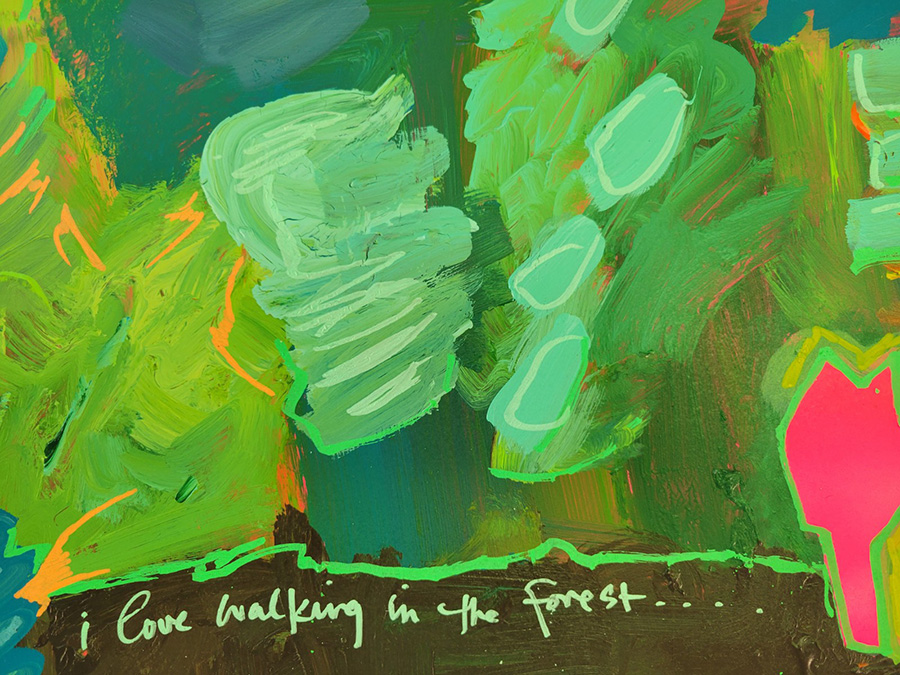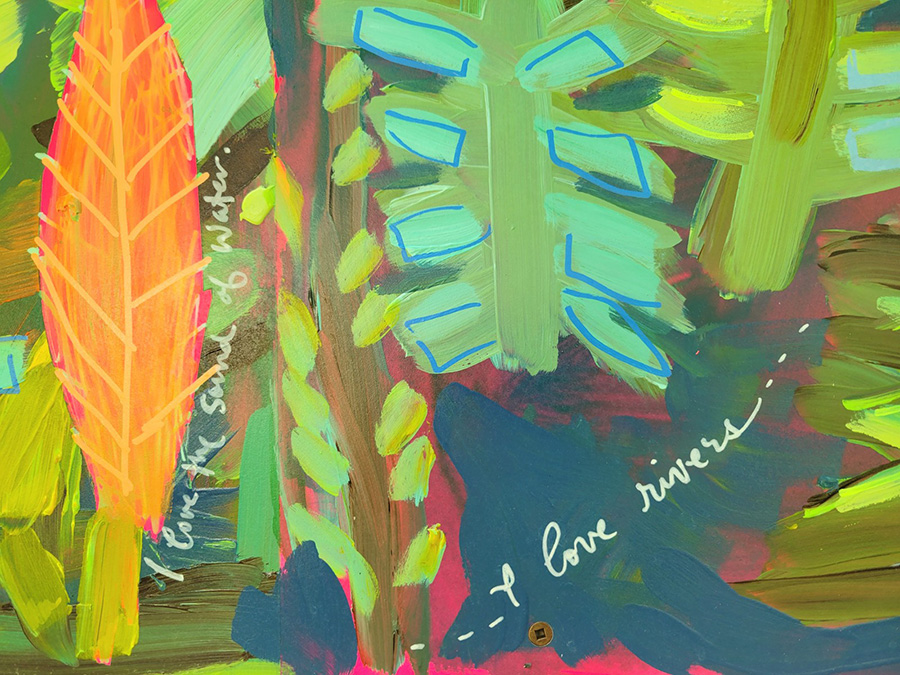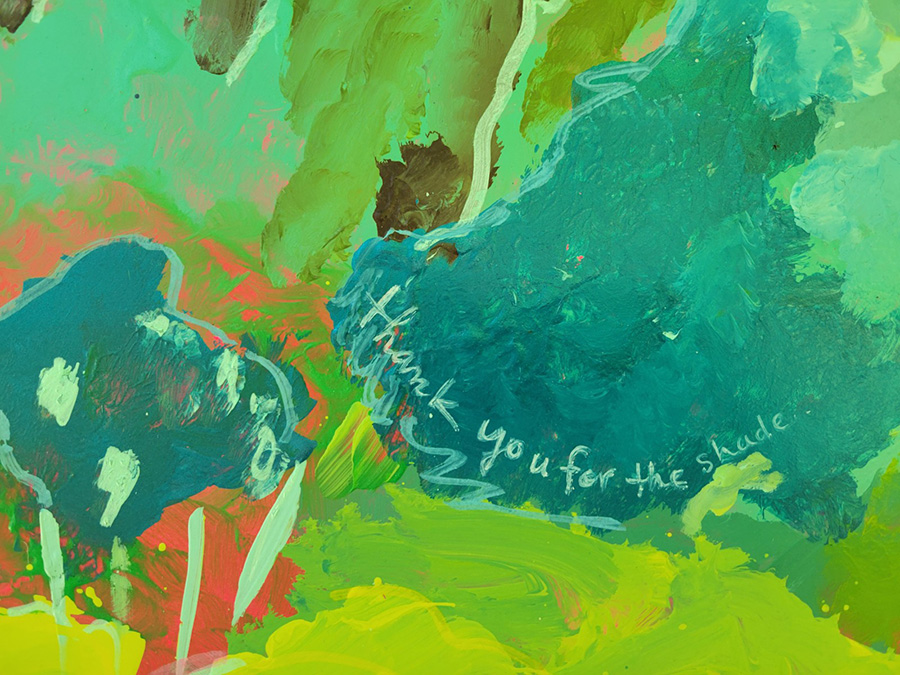Meet the Supportive Arts Crew

Floating Paddles of Hope – Artist Statement
Each paddle was hand painted by our Supportive Arts participants, inspired by two powerhouse women who each embraced the beauty and diversity of the ancient BC forests 100 years apart! Canadian art icon Emily Carr and Canadian author and Professor of Forest Ecology Dr. Suzanne Simard. Both women are “outsiders” in their own way and share their concern for the BC forests and the devastating effects of clear-cut logging and deforestation.
Each artist selected a word that is meaningful to them as they reflected on their own connection to nature. The words create a floating message of hope while the tree images remind us of the power and connectedness of forests and how important we are to each other.
Supportive Arts is a weekly Art and Mindfulness program at the Elora Centre for the Arts that serves adults with (dis)abilities from our community. This vital program is generously funded by The Ontario Trillium Foundation.
Acrylic, latex, vinyl on basswood paddles, 2022.
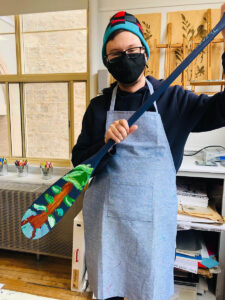

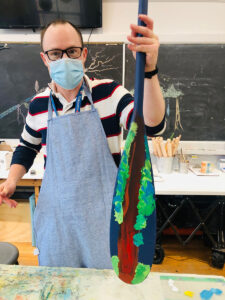
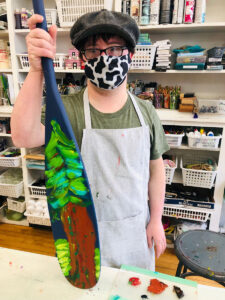
Floating Paddles of Hope – The Process
 ECFTA Art instructor Judy Anderson lead our Supportive Arts group in this art project to create a dedicated space within our Pathways Project that would help celebrate our participants, and acknowledge our natural surroundings in meaningful ways. Paddles were hand painted by each Supportive Arts participant, inspired by two powerhouse women who each embraced the beauty and diversity of the ancient BC forests 100 years apart! Canadian art icon Emily Carr and Canadian author and Professor of Forest Ecology Dr. Suzanne Simard. Both women are “outsiders” in their own way and share their concern for the BC forests and the devastating effects of clear cut logging and deforestation. While we created our paddles, Mindfulness Facilitator Stephanie Lines Toohill shared her knowledge about “The Mother Tree” and the amazing way that trees are connected, supporting each other and communicating through their root system.
ECFTA Art instructor Judy Anderson lead our Supportive Arts group in this art project to create a dedicated space within our Pathways Project that would help celebrate our participants, and acknowledge our natural surroundings in meaningful ways. Paddles were hand painted by each Supportive Arts participant, inspired by two powerhouse women who each embraced the beauty and diversity of the ancient BC forests 100 years apart! Canadian art icon Emily Carr and Canadian author and Professor of Forest Ecology Dr. Suzanne Simard. Both women are “outsiders” in their own way and share their concern for the BC forests and the devastating effects of clear cut logging and deforestation. While we created our paddles, Mindfulness Facilitator Stephanie Lines Toohill shared her knowledge about “The Mother Tree” and the amazing way that trees are connected, supporting each other and communicating through their root system.
Each artist selected a word that was meaningful to them, and a word that they felt might encourage others. Each word appears on the reverse side of each artist’s paddle.
The paddles are suspended from tree branches as part of the Centre’s Paths that Connect Us project. The words create a floating message of hope while the tree images remind us of the power and connectedness of trees and how important we are to each other.
Supportive Arts is a weekly Art & Mindfulness program at the Elora Centre for the Arts that serves adults with (dis)abilities from our community. This vital program is generously funded by the Ontario Trillium Foundation.
To find out more about our Supportive Arts program for adults with (dis)abilities please click here.
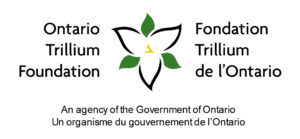
Installing the Paddles
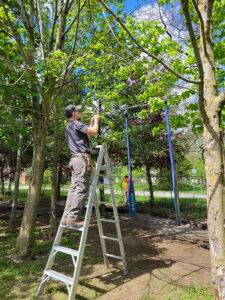
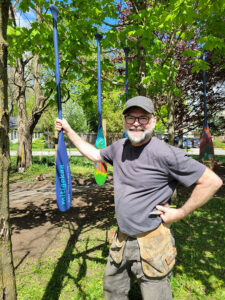

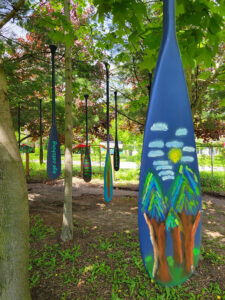
To create the “floating” effect, installer Jim Todd hung aircraft wires and clamps so that the paddles could swing freely in the breeze without sliding out of place.

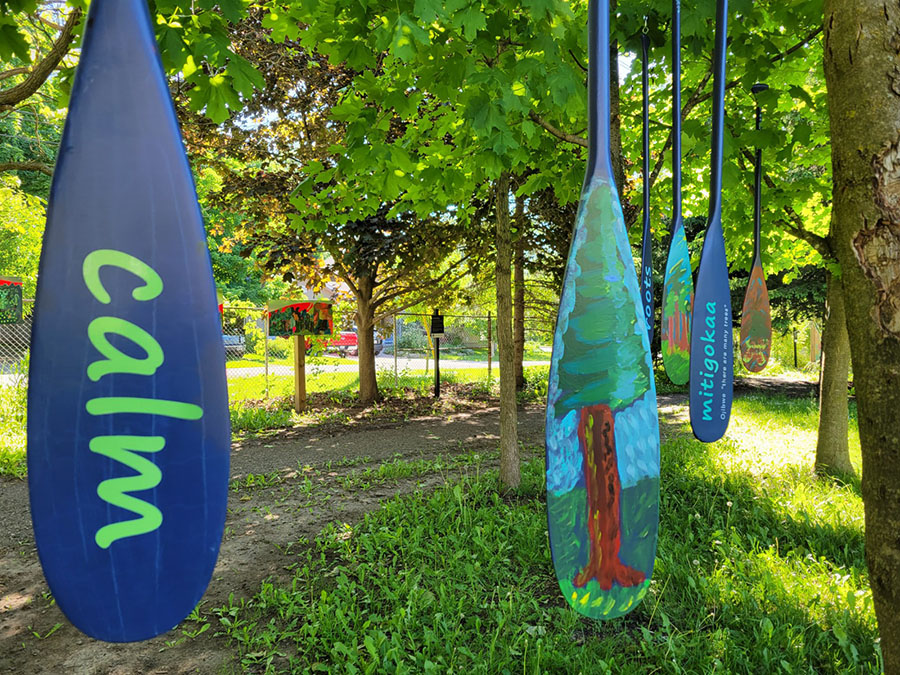
Our Connected Landscape – Metal Art Panels
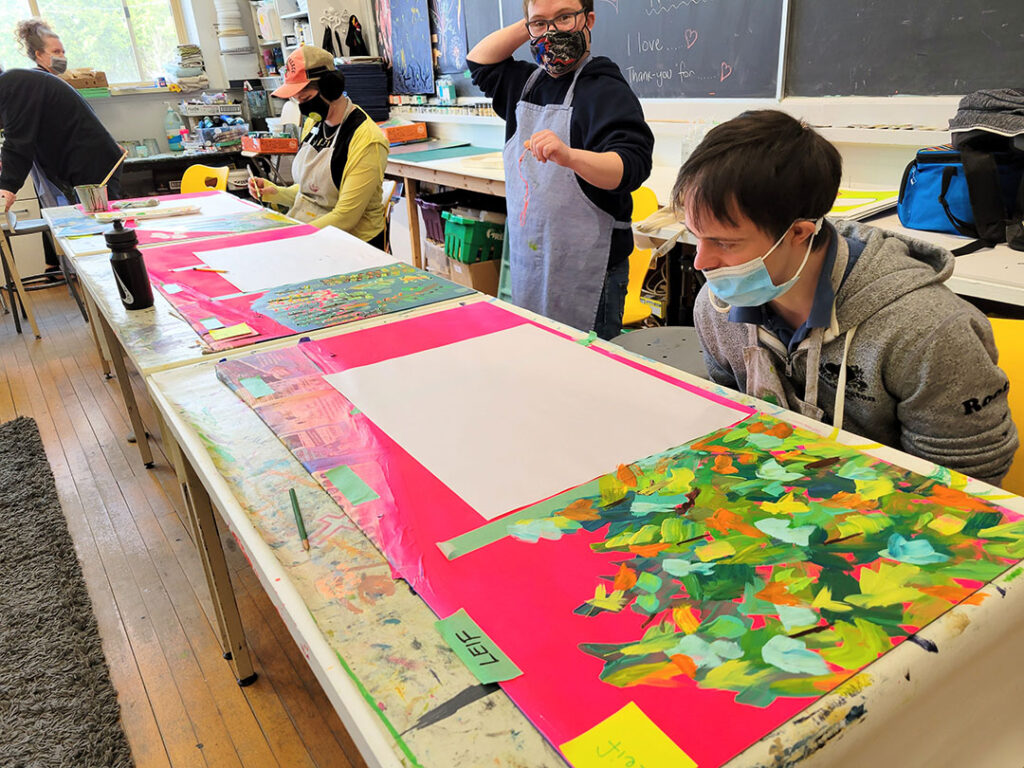
Elora Centre for the Arts’ Supportive Arts program for adults with (dis)abilities often looks to the land for our subject matter, as many of our favourite artists have done before us. During our 2021-22 season, we turned to the Group of Seven for inspiration. Artists such as AJ Casson, Lawren Harris, Tom Thompson and Emily Carr are explorers in a way. Explorers in art making, but also explorers who ventured north into the Canadian landscape to help form a sense of a shared identity and connect us to the land.
While the landscape often serves as a silent “sitter” on display for the viewer, in our Supportive Arts classes, we have endeavoured to gently address issues of land use and climate change, and to be mindful of the land we share with our animal friends, neighbours and those who lived here before us.
Our Connected Landscape – Artist Statement
The Elora Centre for the Arts’ Supportive Arts program for adults with (dis)abilities often looks to the Group of Seven who were explorers in art making, but also explorers who ventured north into the Canadian landscape to help us form a sense of shared identity that connects us to the land.
This undulating landscape installation invites us to see theconnection in all things – to each other, to the earth, to our history. The use of fluorescent pink expresses our concern about our warming planet and the negative spaces represent a thank you to the many trees and forests that have been removed from the land for our own use.
Supportive Arts is a weekly Art and Mindfulness program at the Elora Centre for the Arts that serves adults with (dis)abilities from our community. This vital program is generously funded by The Ontario Trillium Foundation.
Acrylic and latex on aluminum
2022
Our Connected Landscape – The Process

Each panel was divided into three sections. Each participant was responsible for one section each, and interpreted the landscape in their own way. The top portion of each panel was taped off, so that when peeled away, only the original aluminum remained. This “negative space” represents our thank you to the many trees and forests that have been removed from the land for our own use.
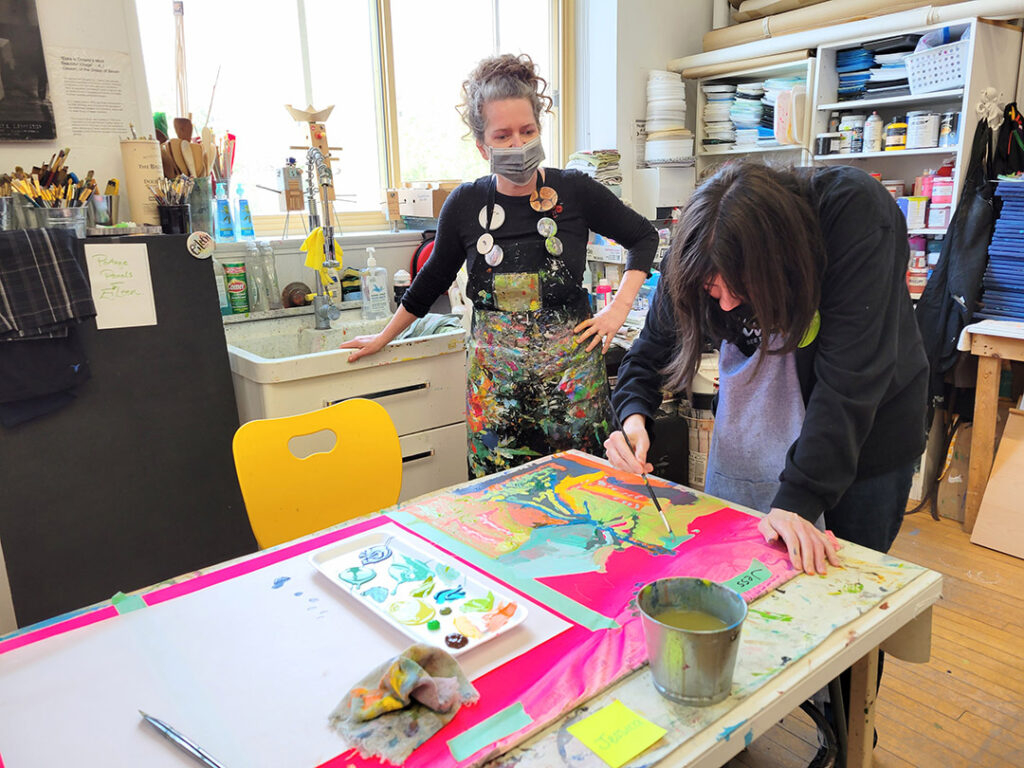
You will notice that we used a lot of fluorescent pink in our panels – this colour choice was intentional, as it expresses our concern about our warming planet.
A total of 24 Supportive Arts participants contributed to the creation of these 8 panels – we encourage you to walk by the full installation to experience the “movement” of the landscape and the flow of trees that connect to make a living forest.
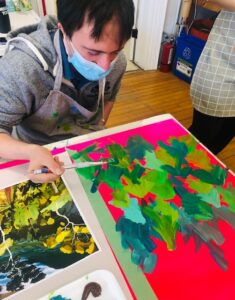
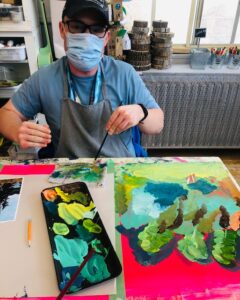
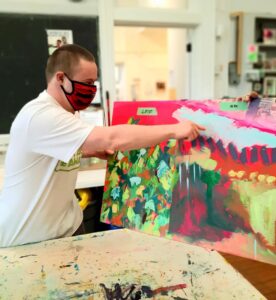

Each panel features the work of 3 Supportive Arts participants, from different weekly groups. They may not have known the person they were painting “beside” but through art they were connected!
Our Connected Landscape – the Installation
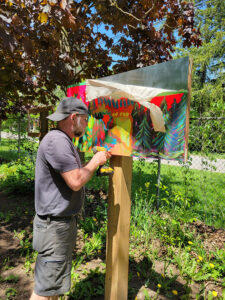
We dug and installed 8 pressure treated posts for this installation. The horizontal metal art panels were spaced so that as you walk the pathway, you notice the “movement” of the horizon at the top of each piece.
Make sure to notice the words written on each panel – words of thanks to nature and our forests.


